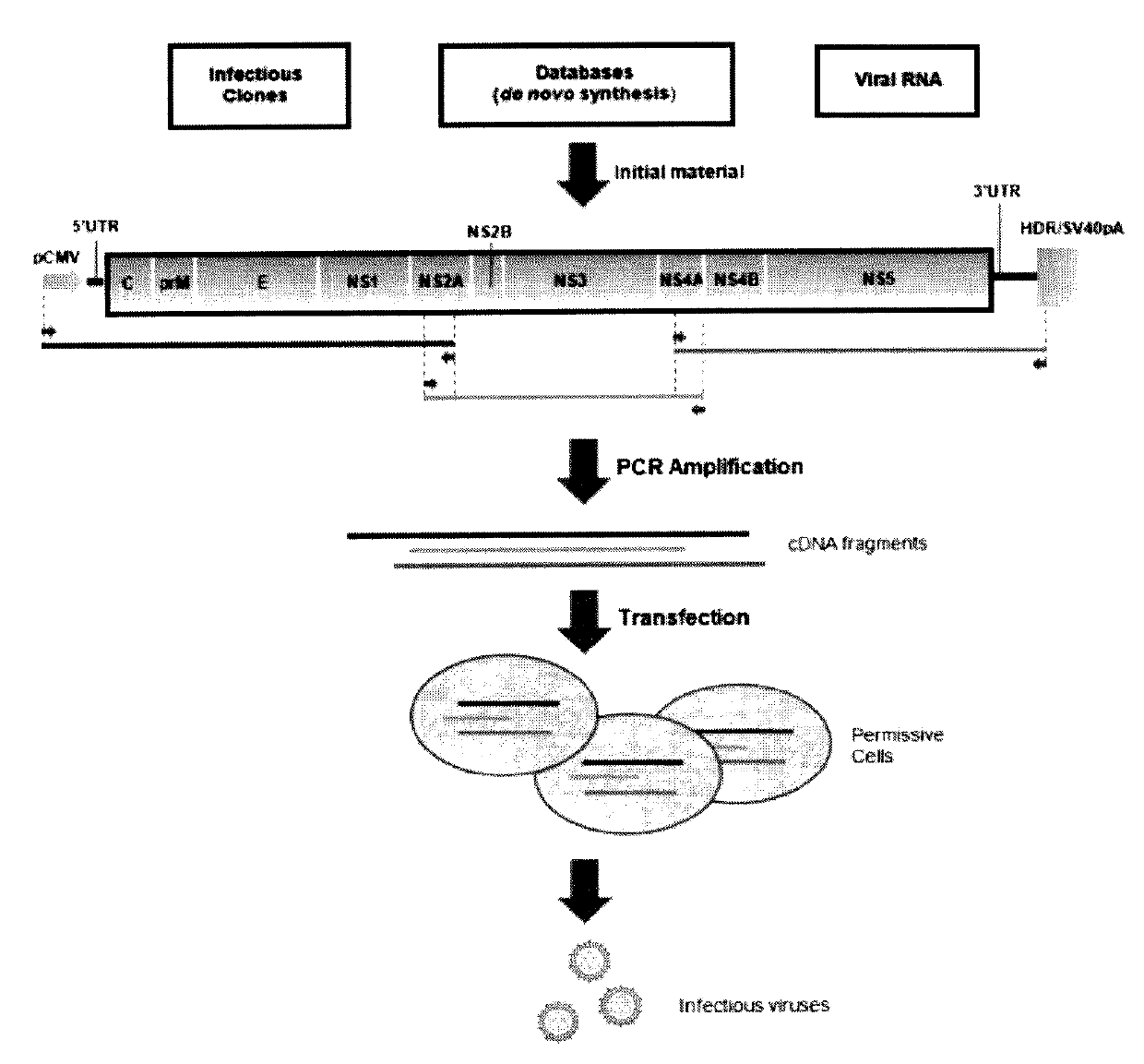Method for rapid generation of an infectious RNA virus
a technology rapid generation, which is applied in the field of rapid generation of infectious rna virus, can solve the problems of substantial optimization, unpredictable current methodologies for the construction of infectious cdna clones, and lack of a unified methodological process
- Summary
- Abstract
- Description
- Claims
- Application Information
AI Technical Summary
Benefits of technology
Problems solved by technology
Method used
Image
Examples
example 1
ISA Method
[0108]Methods
[0109]Cells, Viruses, Infectious Clones and Antibodies
[0110]Baby hamster kidney (BHK-21) cells were grown at 37° C. with 5% CO2 in a minimal essential medium (Life Technologies) with 7% heat-inactivated foetal bovine serum (FBS; Life Technologies) and 1% Penicillin / Streptomycin (PS; 5000 U / mL and 5000 μg / ml; Life Technologies). Human embryonic kidney 293 (HEK-293) cells and African green monkey kidney (VeroE6) cells were grown at 37° C. with 5% CO2 in the same medium than BHK-21 cells supplemented with 1% of non-essential amino acids (Life technologies). Human adrenal carcinoma (SW13) cells were grown at 37° C. with 5% CO2 in RPMI 1640 medium (Life Technologies) with 10% FBS and 1% PS. JEV genotype I strain JEV_CNS769_Laos_2009 (KC196115) was isolated in June 2009 from the cerebrospinal fluid of a patient in Laos16; YFV strain BOL 88 / 1999 (KF907504), isolated in 2009 from a human serum, was kindly provided by the National Center of Tropical Diseases (CENETROP)...
example 2
Method ISA with cDNA Fragments in Individual and Separate Plasmids
[0143]The inventors further illustrated the ISA method in the specific embodiment where step c) is a step of transfection of plasmids or vectors comprising a cDNA fragment obtained in step b), wherein each cDNA fragment is in individual and separate plasmid or vector.
[0144]This experiment was performed using three plasmids containing the same fragments of the Japanese Encephalitis virus genome (Genotype I, Laos strain) as those previously used for recovering infectious virus by the ISA method after PCR amplification.
[0145]The three plasmids were linearised by digestion with the restriction enzyme Fse I and directly transfected in equimolar quantity (1 μg final) into SW13 cells without prior PCR amplification. After 9 days and 1 passage, the virus was successfully recovered from culture.
example 3
Application of the Method ISA In Vivo
[0146]Overlapping fragments covering the entire genome of RNA viruses and flanked respectively at 5 and 3′ by promoter of DNA-dependent RNA polymerase and terminator / RNA polyadenylation signal were prepared using the method of the invention.
[0147]These DNA fragments were directly inoculated to live animals and allowed to recover infectious virus from several animal samples. In addition, clinical surveillance of animals (appearance of symptom and significant weight loss) allowed to observed typical signs of infection.
PUM
| Property | Measurement | Unit |
|---|---|---|
| volume | aaaaa | aaaaa |
| volume | aaaaa | aaaaa |
| volume | aaaaa | aaaaa |
Abstract
Description
Claims
Application Information
 Login to View More
Login to View More - R&D
- Intellectual Property
- Life Sciences
- Materials
- Tech Scout
- Unparalleled Data Quality
- Higher Quality Content
- 60% Fewer Hallucinations
Browse by: Latest US Patents, China's latest patents, Technical Efficacy Thesaurus, Application Domain, Technology Topic, Popular Technical Reports.
© 2025 PatSnap. All rights reserved.Legal|Privacy policy|Modern Slavery Act Transparency Statement|Sitemap|About US| Contact US: help@patsnap.com

